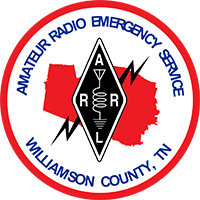[Video] AD4CJ Presents HF Tweaking
Longtime member Tim Kreth, AD4CJ delivered a fantastic presentation at the August edition of WCARES Chew & Chat. Due to popular demand he has digitized his presentation into the form of a YouTube video presenting some valuable information about how to maximize your High Frequency capabilities.
What is ARES?
Amateur Radio Emergency Service® (ARES)
The Amateur Radio Emergency Service® (ARES) consists of licensed amateurs who have voluntarily registered their qualifications and equipment, with their local ARES leadership, for communications duty in the public service when disaster strikes.
ARES Organization:
Williamson County Ares is part of District 4 of the Tennessee section of the Delta Division of ARES.
Scott Gray, KD4VVC is the Emergency Coordinator of WCARES
Jim Humphrey, K4OFC is the District Emergency Coordinator
Keith Miller, N9DGK is the Section Manager
The Delta Division is made up of the Arkansas, Louisiana, Mississippi, and Tennessee Sections
David Norris, K5UZ is the Director
Ed Hudgens, our very own WB4RHQ is the Vice Director
Radio at War – 1944
An excellent film brought to us by RCA (Radio Corporation of America), 1944. It is the story of two teenage brothers, both amateur radio operators, who joined the Navy during World War II, and shows how radio helped win the war. Thanks, Scott (KD4VVC), for making us aware of this film.
Monday Night WinLink Net
Ladies and Gentlemen,
The Winlink Net is back. In the subject line please put “net”, and in the message body put your power source. The reason for that is that once per month, as you know, we do check-ins on the regular net with an emphasis on alternate power, and instead of sending out a reminder on those weeks it will be much easier if you simply include it in the message body each time that you check in so that it’ll be already be there and will be habit.
Winlink will now be allowed as a means to check into the regular Monday night net. Anyone wishing to check into the regular Monday night net by way of Winlink should send an email to WC4EOC@winlink.org by way of RF only. Telnet check-ins do not count, since it seems only logical that if it’s to be allowed to count as a check-in to the regular Monday night net, simply sending an email through the internet defeats the purpose of what the net is trying to accomplish.
Your message should be sent Monday after 7 a.m. and no later than 6 p.m. so that all stations using Winlink have the time to receive an acknowledgement and to get tabulated and passed on to whoever is the NCS for that night.
73,
-- Robin Patty K4IDK
Fractal Antennas For Ham Radio
Presented by Jack Hill – W4KH – w4kh@nanniandjack.com
Fractal Geometry is a particularly difficult concept for many people to grasp… Many of you may have heard of “Mandelbrot Sets”, so named for, to quote Wikipedia: “Benoît B. Mandelbrot (20 November 1924 – 14 October 2010) a Polish-born, French and American mathematician, noted for developing a “theory of roughness” in nature and the field of fractal geometry to help prove it, which included coining the word “fractal”. He later discovered the Mandelbrot set of intricate, never-ending fractal shapes, named in his honor.
I invite the reader to “Google” Mandelbrot and become more familiar with his work and how he came to rely on graphic images to foster his understanding of math concepts…
For the really curious, make sure you have a good version of Java (https://www.java.com) and then Google for “online fractal generator” and make your own!
When it comes to Fractal antennas, the field is in its infancy, although cellular telephones have made prolific use of these small, broadband, and efficient antennas. Because of the complexity of building an antenna using repeating patterns whose angles, leg dimensions, and overall pattern must be precisely executed for optimum performance, fractal antennas have not yet made significant inroads into HF operation, especially the lower frequencies (longer wavelengths). That said, one example of a “simple” fractal antenna is the log-periodic, whose elements are scaled from back to front in a manner that allows continuous transmit and receive coverage for a wide slice of spectrum, for example from 7.0 MHz to 30 MHz. Take particular note of the first URL presented, as M0WWA from the UK has designed and built a 28 MHz (ten meter) fractal antenna with pretty good results.
I have put together some URLs that will get your curiosity up and let you explore. Follow other pages in the URLs and links to other pages… if these are not enough, remember Google is your friend!
M0WWA Fractal Antenna Designs
http://www.m0wwa.co.uk/page/M0WWA_fractal_antenna.html
Wikipedia – Fractal Antenna
http://en.wikipedia.org/wiki/Fractal_antenna
Fractal Geometry Panorama
http://classes.yale.edu/fractals/panorama/ManuFractals/FractalAntennas/FractalAntennas.html
Fractal Antennas
http://www.qsl.net/kb7qhc/antenna/fractal/
Fractal Antennas: Hype or Hope?
http://www.kb6nu.com/fractal-antennas-hype-or-hope/
Fractal Antenna for ham radio bands : resource detail
http://www.dxzone.com/dx26559/fractal-antenna-for-ham-radio-bands.html
Ham Radio: Old Technology Gets New Respect
Fox News recently did a feature on Ham Radio, which you can watch here:
http://www.foxnews.com/tech/2014/05/19/ham-radio-old-technology-gets-new-respect/? intcmp=features
Shortwave Radio in WWII
From Scott Gray, KD4VVC:
Click here to see a great documentary on the role of Hallicrafter radios in WWII.
Spy Radio in World War II: “Strategic Service Transmitter-Receiver Number 1” SSTR-1
From Scott Gray, KD4VVC:
Circa 1943. “Office of Strategic Services. Field Photographic Branch… Click here to view Instructional Film: Describes the radio transmitter-receiver unit used during World War II. Explains compactness and ease of concealment, and outlines operations in detail: selection of electrical outlet, battery, or combination of both as power unit; antenna, assembly parts, installation, frequency determination and receiver operation; parts installation, attachment of crystal equipment and transmitter operation.”
